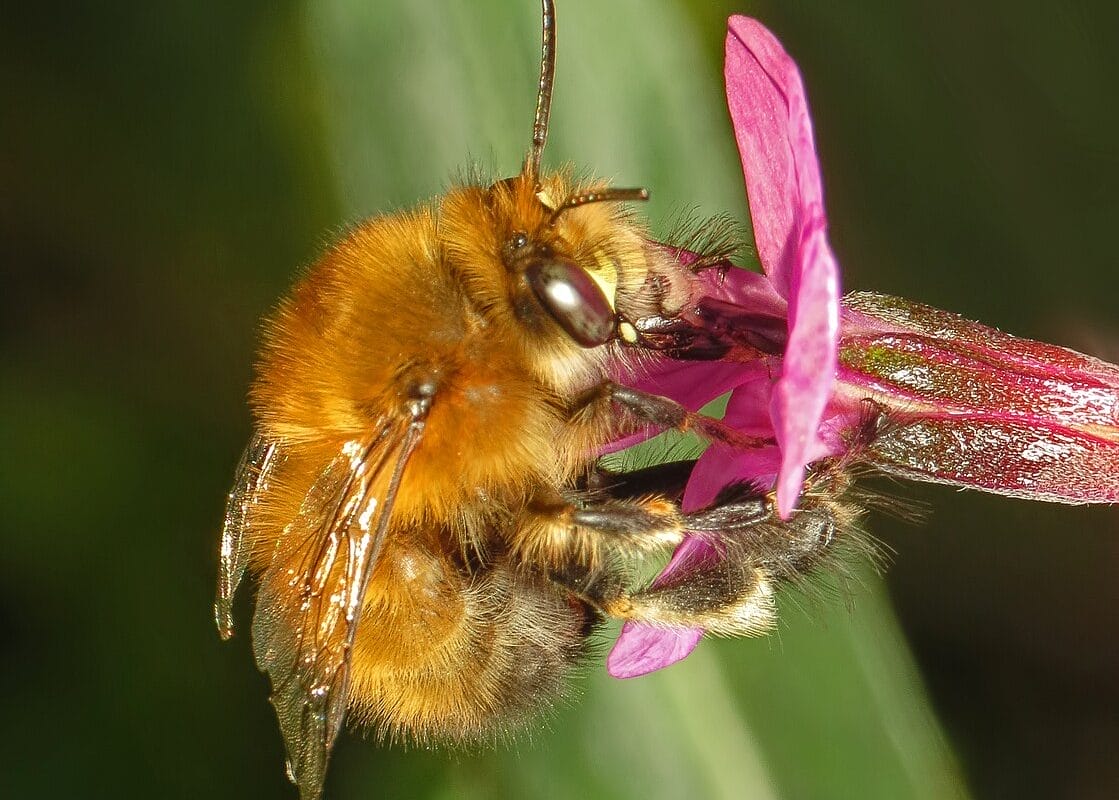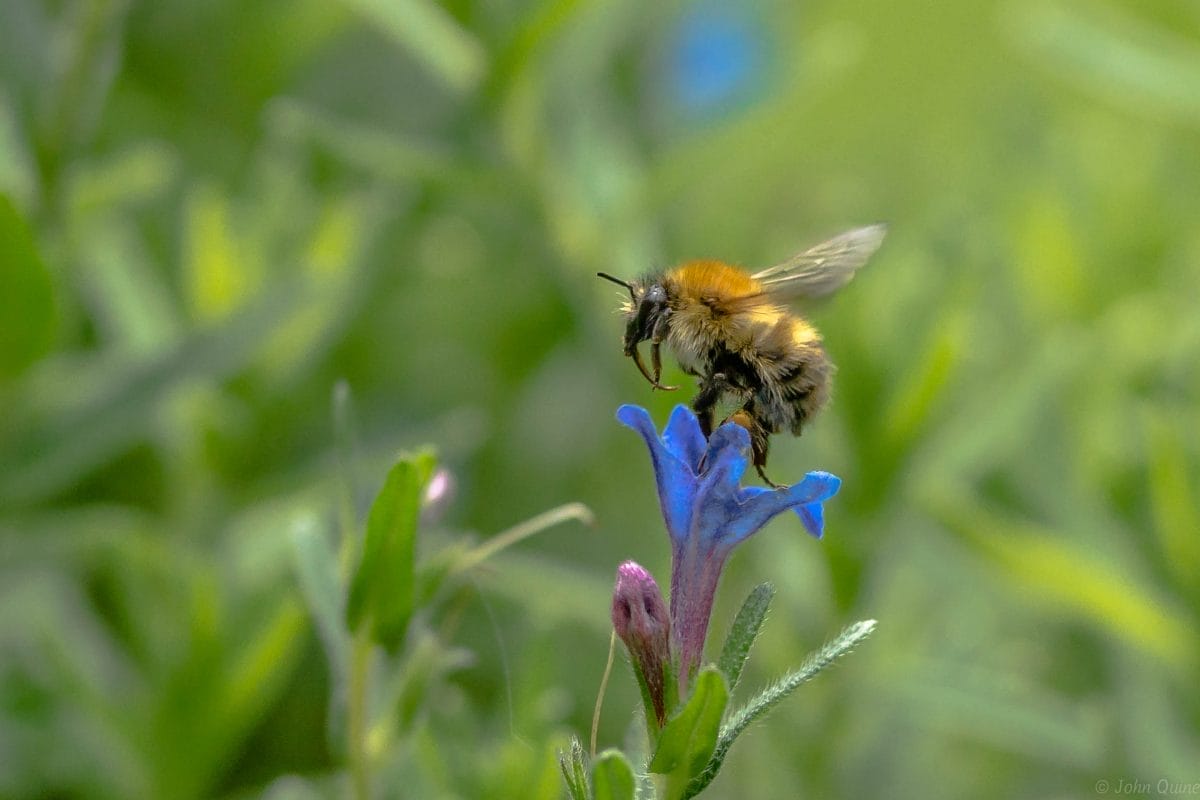A few years ago, when I first started my regular walks down the Nature Trail, I was intrigued by the little clusters of gingery bees hovering about over flowers, darting and zig-zagging off as soon as I pointed a camera at them.
Eventually I managed to take a blurred photo of one of them and sent it to a friend. She told me these fellows were male hairy-footed flower bees (Anthrophora plumipes). Every spring since I have been delighted by their arrival (seemingly from nowhere) in March, their characterful high-pitched buzz and general busy behaviour.
Who are these bees?
Hairy-footed flower bees look like bumblebees, but they belong to the larger group of ‘solitary bees’. This grouping includes the ivy bee and mining bees, who we have met in previous posts.
For the hairy-footed flower bee though, the term solitary isn’t entirely accurate. They often lay their eggs in holes near to each other – like in brickwork – in what are known as aggregations: groups of neighbouring bee homes. But unlike bumblebees and honeybees there is no social organisation, no co-operation between individuals, and specific roles. Solitary bees are either male or female – there are no queens or workers.
Where do they come from?
In the summer, the female hairy-footed flower bee will mate. She will make or find a hole in the soft mortar of old walls, chimney stacks, the faces of soft cliffs or quarries, or muddy banks and slopes and lay her eggs. She seals each one up in a separate ‘cell’, each provisioned with pollen and nectar for winter food.
Not all survive. The eggs can be eaten by the larvae of a parasitic bee – the rather sinister-looking Mourning Bee, who lay their eggs in the flower bee’s nest. The Mourning Bee larvae emerge before the flower bee eggs hatch into larvae, and greedily eat not only the nectar and pollen the female flower bee has so carefully stored, but also all her eggs!

Some eggs, hopefully, remain uneaten and over the winter develop into larvae. By early spring, the shiny new flower bees are ready to emerge. HFFBs, as they are known, are among the first bees of the year to emerge, and can sometimes be seen even on sunny late February mornings, though most come out in March. The males emerge first, with their buff-haired thorax and abdomen and pale-yellow hairy face, making them look as if they have a blonde moustache.

How do they live?
The first job of the male is to find a good source of nectar.
They are not fussy, and will feed on whatever flower is out; deadnettle, comfrey, green alkanet, primroses, blackthorn, willow and cherries. But they seem to have a special fondness for pulmonaria, or lungwort, so called as the spotty pattern of the leaves was thought to look like the air sacs of a lung (possibly a diseased lung) – hence the plants were used in the preparation of herbal medicines for lung disorders.
On the Nature Trail there isn’t any pulmonaria, (though you will find some in the rest of the Gardens) but there are primroses and lots of Green Alkanet, so look for HFFBs on your spring walks at the Horniman.
Pulmonaria flowers change colour as they mature from pink to blue, hence their folk name of ‘Soldiers and Sailors’ which refers to the red and blue colour of the respective military uniforms.
In the picture below, our friend is heading – with tongue protruded and serious purpose – towards some pink flowers. He knows that these, being young, are full of nectar. Once the flowers have turned blue, the bees know the flowers are older and empty of nectar so he will not land on them. A perfect example of nature in action, flowers and pollinators having evolved together to avoid waste and working to serve both bee and flower to pass on their genes to the next generation.

The males, hungry after their long winter, will feed themselves up on nectar and build up their strength in the hope they can find a female to mate with. They commandeer what they deem to be particularly good patches of flowers and keep other males off their patch. That way, when the hungry females emerge a week or two later, they will be well-fed and full of energy.
The females are just as beautiful as the males, with their smart black fur and red patch on the hind leg. This is where they store the pollen they collect and will use to provide food for their babies waiting in their winter tunnels.

The males, I am afraid to say, do not go in for a long, polite courtship, for time is critical if you are a bee! So, in the time they are not feeding or defending their territory they wait by the nest sites and pounce on the females, as they emerge, sleepily, into the sun.
Why do they have hairy feet?
The male HFFB has elongated middle legs decorated by brushes of fine hairs – as you can see from the first picture. Before mounting the female bee, he will brush secretions from glands on his abdomen onto his hind legs, and then transfer the odour to the middle legs. During mating, he will use his long, brush-like middle legs to tap and transfer the odour onto the female’s antennae.
Why does he perform this rather complicated ritual? And why do other bees not do something similar? I have a big book about solitary bees, and I cannot find the answer there, nor have a found much of use on the internet. So perhaps it is not known. (If you do know, please get in touch).
I wonder if the male is in effect “marking” the female, saying in effect to other males, “She’s mine, go and find someone else to mate with”. Or perhaps the male is, through his stroking and tapping, demonstrating dexterity which the female finds ‘attractive’ because offspring will be better at extracting nectar and pollen if it is an inherited trait. Who knows?
Here’s a video which tells the story of a flower bee. Warning – contains bee violence and scenes of a sexual nature!
I hope you liked that little film. I think it gives you a tiny glimpse into a world of sexual rivalry and death and tragedy playing itself out, unbeknown to us, right under our noses, in our gardens and parks.
It is hard not to be anthropomorphic when you see the struggles these animals have just to survive and continue the next generation. And perhaps, just perhaps, you get the sense that they might for a few fleeting moments experience a sense of joy in their tiny brief lives – as they emerge from a dark hole into a scented walled garden in the April sun, hungry for nectar and hoping for love.
There is now some fascinating research showing how sophisticated the brains of bees are, so this may not be as far-fetched as it seems. That’s for another time, maybe.
In the meantime, have a walk down the trail or anywhere where there are spring flowers, and enjoy being a part of the short but exciting life of the hairy footed flower bee or HFFB.


